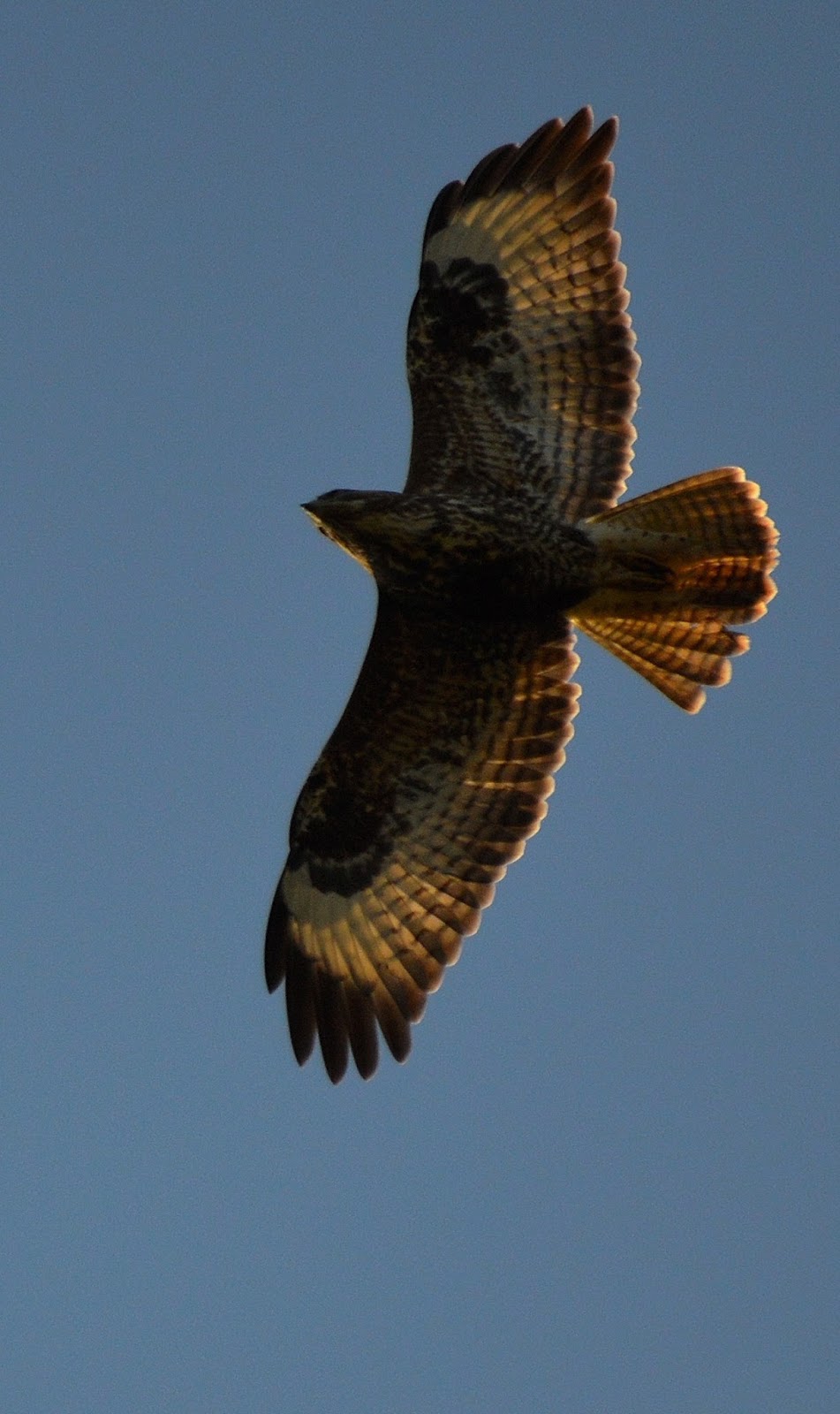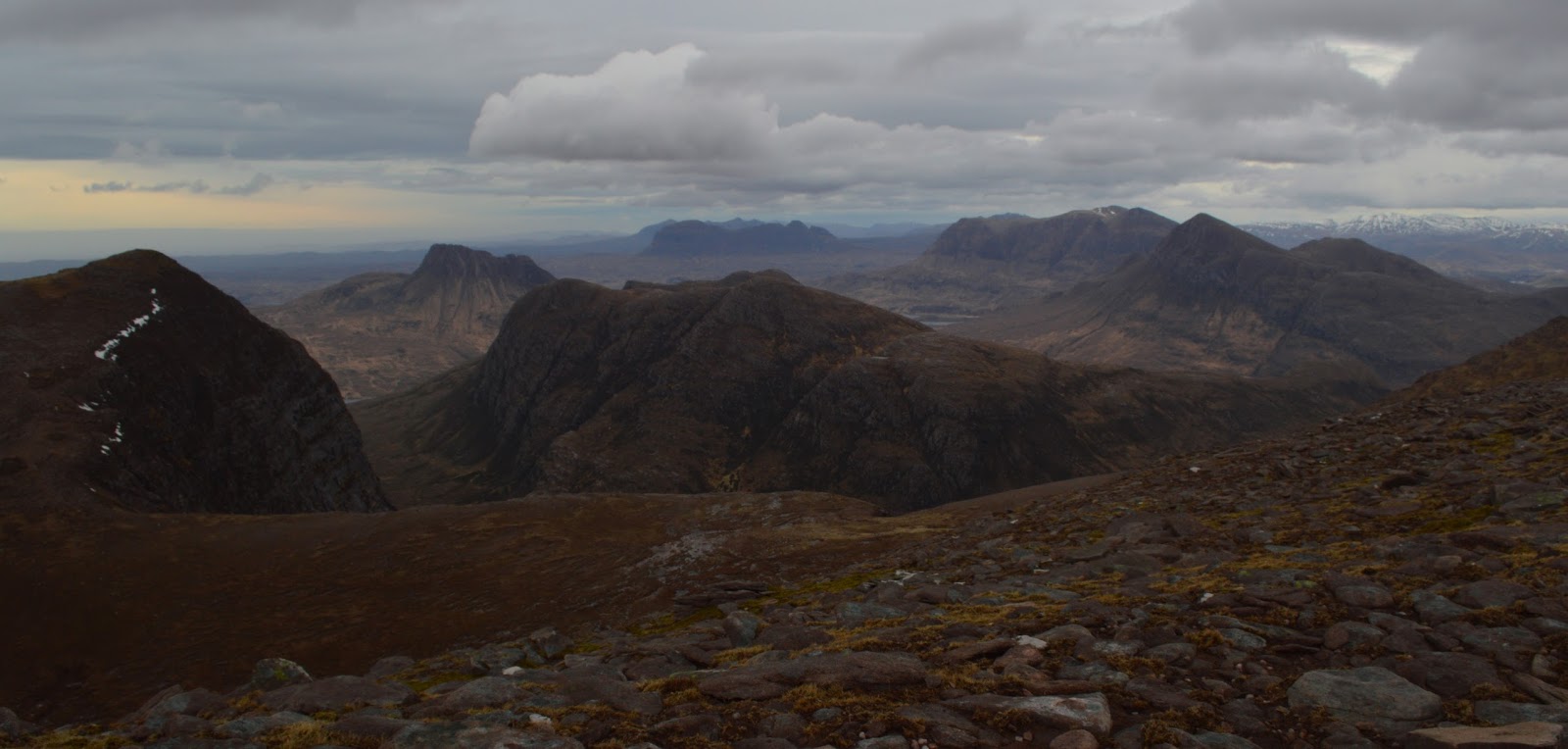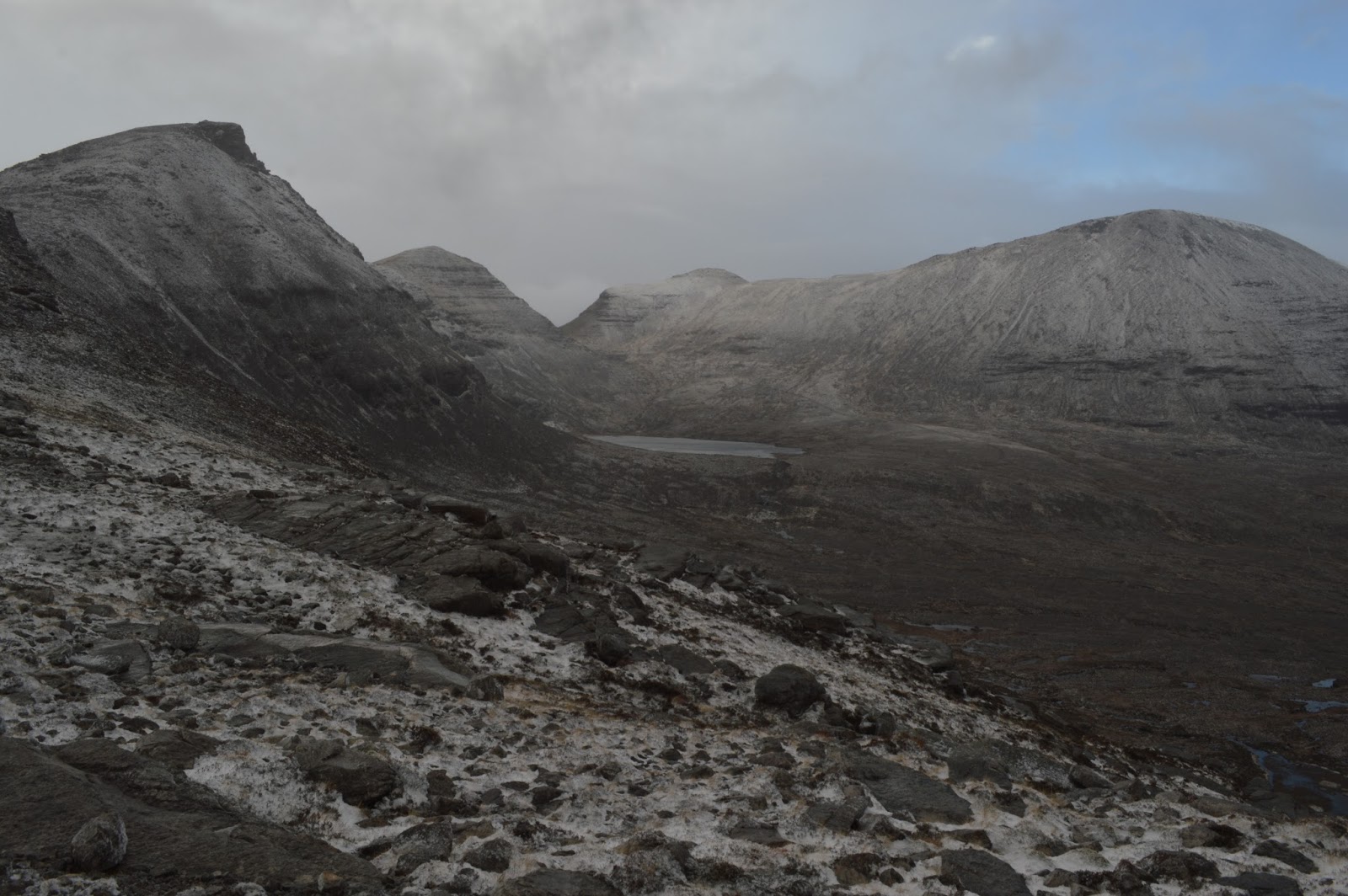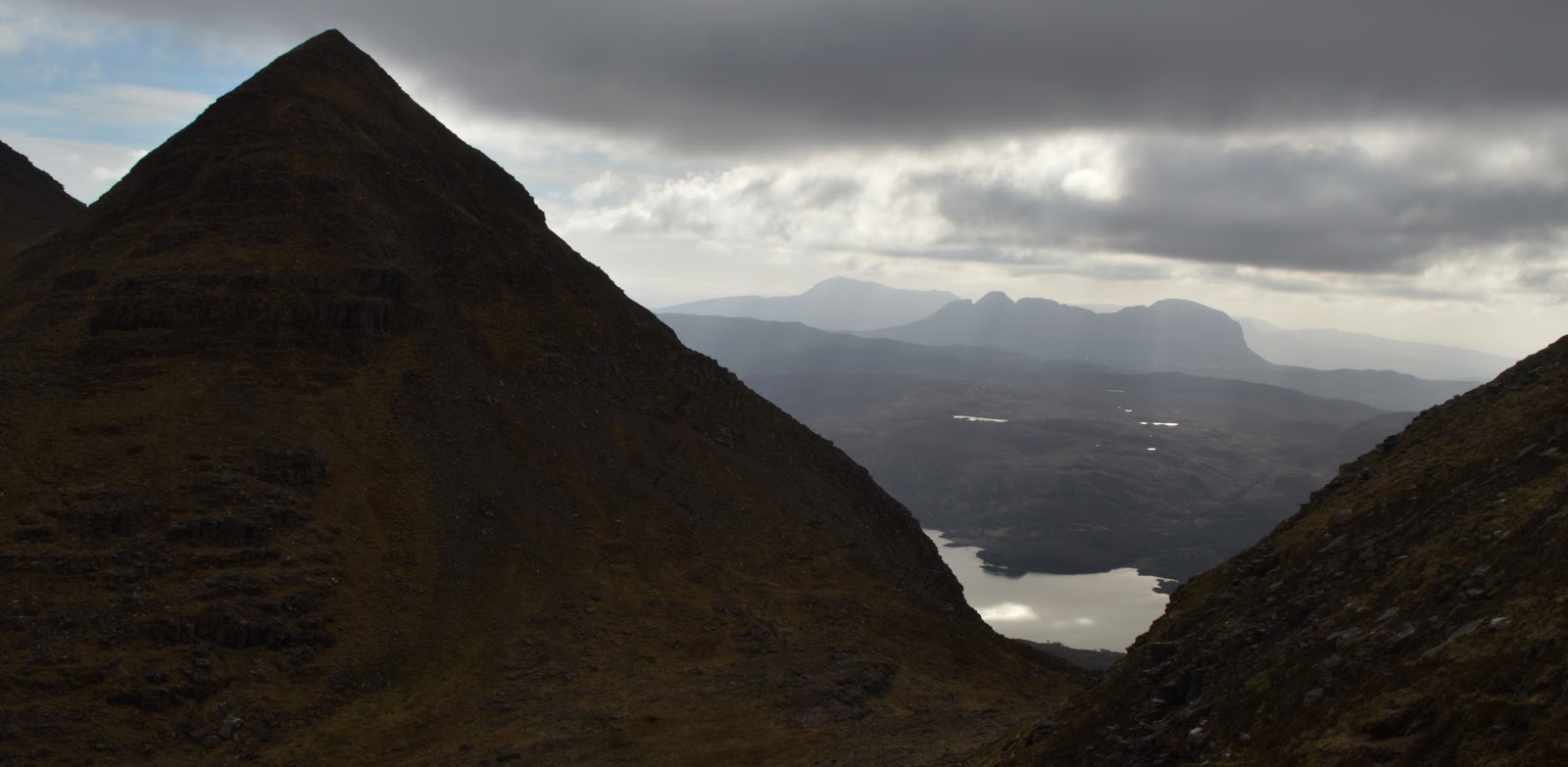After spending the first half of my study leave reading and in archives, I decided to book myself an isolated spot in the NW corner of Scotland - the Achiltibuie Salmon Bothy - to actually write. This allowed for a couple of mountain days on the long journey north.
First Night:
I picked Ben up in Glasgow and we headed to Skye, hoping to get into the Black Cuillin which, as usual, was stubbornly cloud-bound. We made for the Quiraing instead: I'd never been, but wonderful shots of it by people like Joe Cornish have long made it appealing. The least spectacular night of the trip, this was still pretty special. It's one of the weirdest landscapes in Britain, with a strange grassy 'table' surrounded on all sides by fortification-like cliff faces (where crofters, apparently, used to hide cattle from the authorities). We passed round the bottom of the cliffs in the rain, with just the odd photo opportunity:
Then we headed up the far side and were looking down from the table at dusk.
A beautifully clear night, with only a couple of showers, featured plenty of meteors (no northern lights though). We were back at the table by dawn as clouds swept across at speed, shedding small amounts of snow.
...the sun was breaking through to generate the kind of glow that only the far NW really gets:
...surely one of the most spectacular car parks in Britain.
Next Trip:
We had a brief detour to Glen Brittle (the rain and gloom was too persistent to bother getting the camera out), then gave up on the cuillin and headed for the mainland. Couldn't resist adding 40 mins to the journey by taking the Applecross pass: snowbound and spectacular. Then we descended into Torridon to get in amongst the peaks. With mixed weather forecast, we chose one that only takes c.6 hrs to get up and down, though the shortish distance means a strenuous climb. This mountain, Meall A Ghiuthais, also tends to miss the cloud that clings to Beinn Eighe, Liathach and Alligin. This was a spectacular day. The mixture of sun and high, dark cloud made for dramatic conditions, while fresh snow allowed a straightforward ascent with plenty of bite for the crampons.
We set off up the Beinn Eighe reserve's 'mountain track' which took us to c.500m. This provided superb views of Slioch all the way up; as the forecast had predicted sunny spells were alternated with sleet showers, leading to the usual mountain rainbows.
These made light work of the ascent
This was the best place to look down Loch Maree to the Atlantic:
And to view the only rival to the Black Cuillin as Britain's finest ridge walk, An Teallach:
The bothy is a wonderful little building (or rather, room). Once used for salmon fishing...
...it now has all mod cons including underfloor heating (although thankfully no tv). The conversion from a place to keep nets, store and box salmon, to a characterful, cosy habitation was inspired:
For more (and better) views in and around the bothy, have a look at this instagram.
Trip 3:
We'd planned to head up a Coigach Corbett next morning, but the weather was grim and the cloud in, with clearer skies forecast for the afternoon. I drove Ben to Inverness for the Glasgow train first thing, then headed back, planning to scale whichever peaks were clear first. With Torridon and Dundonnell in cloud I ended up back in Coigach. I decided to head up diminutive Beinn an Eoin. But just as I set off, the cloud began to clear from a more enticing prospect: Cul Beg.

Heading back down hill, it was getting quickly darker.
Next morning was grey. I stayed in, writing a chapter on historical geography, which seemed appropriate. I'd intended this to be a solid day of work, but about 11ish, the cloud disappeared: a quick paddle round the Summer Isles was irresistible. I paddled out to a small island next to Tanera Beg past flocks of pink footed geese and odd razorbills and black guillemots. There were also lots of tiny redshank and turnstone feeding in the seaweed:
Trip 5:
On the
way back down, during breaks in the rain, it was possible to appreciate the
views I'd been missing on the way up. Here's one for my Dad: Sgurr an
Fhidhleir.
I was
back shortly before lunchtime, ready to poach a smoked haddock from the Achiltibuie stores and spend the
afternoon with Mary Ward.
The next break in the rain was at the opposite end of the day, leaving just enough time to sprint up Stac Pollaidh as night fell.
The next break in the rain was at the opposite end of the day, leaving just enough time to sprint up Stac Pollaidh as night fell.
Final Trip:
For the next few days, I got up early and wrote until about 2, then headed up a mountain for four or five hours, before getting back to the bothy to spend the evening reading with a glass or two of Talisker. A few hours was quite enough mountain on these days, because the winds were fierce. I crawled (literally at times) up Cul Mor and Ben Mor on days when the forecast said this: 'Storm to hurricane force upland winds. Southerly, in the range 60 to 80mph, gusts to 100mph. Considerable buffeting from many lower slopes upwards; across the mountains, where exposed, any mobility tortuous'. It wasn't exaggerating. Alongside these winds, a thaw set in, taking all the snow off the Coigach peaks. The views down Loch Broom from Ben Mor were excellent (even from this many hundred metres up, the effects of the wind could be seen on the sea):
For the next few days, I got up early and wrote until about 2, then headed up a mountain for four or five hours, before getting back to the bothy to spend the evening reading with a glass or two of Talisker. A few hours was quite enough mountain on these days, because the winds were fierce. I crawled (literally at times) up Cul Mor and Ben Mor on days when the forecast said this: 'Storm to hurricane force upland winds. Southerly, in the range 60 to 80mph, gusts to 100mph. Considerable buffeting from many lower slopes upwards; across the mountains, where exposed, any mobility tortuous'. It wasn't exaggerating. Alongside these winds, a thaw set in, taking all the snow off the Coigach peaks. The views down Loch Broom from Ben Mor were excellent (even from this many hundred metres up, the effects of the wind could be seen on the sea):
In these conditions the
long and airy razor-sharp ridge felt like an expedition in itself:
Looking for something
special to end the trip, I decided to head north. Coigach, Suilven and the Culs
might feel like they're in the far north, but in fact some of Britain's most exceptional mountains require a drive even further. Quinag, Arkle, Foinaven and Ben
Loyal provide some of the very best mountain days in Scotland. (As a rule, for every hour you drive N of Fort William the mountains get a bit smaller but a lot more characterful). Each is complex,
made up of multiple peaks, long ridges and weird, unworldly geology. My initial plan was Ben Loyal, the most northerly of the four, but I decided against it
because in the low March sun, with the possibility of haze, northerly views
were clearer than those to the south. I chose Arkle and Quinag
instead.
Arkle is Foinaven's twin.
This time last year I had a superb day in rare March snow on Foinaven
(despite being nearer the Arctic than Juneau in Alaska, the gulf stream means
that the mountains of the extreme north rarely get extended snow cover).
Foinaven's intricate ridges make it one of my absolute favourite Scottish
mountains. It was once a Munro (until the ordnance survey realised it had been
miss-measured) - I'm deeply grateful that it was downgraded: it retains that
sense of untouched isolation impossible for any mountain that's part of the Munro-bagging
grind. That trip last year had been a circuit taking in Foinaven then Arkle. I'd made the
stupid mistake (possibly the worst I've ever made in the mountains) of trying
to traverse the whole of Arkle, descending the precipitous NW side. In the snow, and in
weather that had turned very nasty indeed, this was the closest I've ever come
to needing mountain rescue. There were several points on the traverse when going either on or back had seemed totally impossible. Legs like
jelly, I eventually made it down: soggy, wind-battered and exhausted. The
weather that day had prevented any views from the mountain at all, so this was
my chance to dispel the ghost of last year's fiasco.
If Suilven is like a
geological Bruckner symphony - ostentatious and extravagantly grand (with plummets and scrambles at the E end of the ridge that feel much like a double fugue) - then Foinaven and Arkle are the late Beethoven
quartets of Scottish geology - intricate, gnarled and layered with complexity. Everywhere you look, there are tortuous folds and absurd thrust structures attesting to the three billion years of stresses that made this twisted landscape. The rock these ancient mountains are made of, Lewisian gneiss (capped with quartzite), is among the oldest in the world. Henry Cadell's beautiful 1880s survey of these two mountains is a landmark in the development of geology.
The
reason for all this freakish geology is that these mountains perch at the NE
end of the Moine overthrust which extends from Loch Eriboll down to the south
of Skye. Frank Fraser Darling described this as a 'vast, exceptionally wild
geological sandwich' where the youngest and oldest rocks in Britain are thrown
together. As these enormously different rocks slowly disintegrate their
qualities define the vegetation around them. The vibrant emerald richness of
Elphin and Knockan is a limestone island surrounded by a sea of black bogs
(primeval Lewisian gneiss) and the vast ship-like prows of Suilven and Canisp (barren Torridonian sandstone). But the emerald verdure is long forgotten by the time you reach the bleak magnificence of Arkle's steely quartzite:
Arkle is almost as fine a
ridge as Foinaven, with slabs and pavements at all kinds of angles. Here's the
only flat one:
Quinag is not all that
high, and the ascent starts from the pass between Kylesku and Inchnadamph which has done much of the climbing for you. But the hill consists of so many
separate peaks that going up is like climbing a much higher mountain. This was taken a couple of days before when I'd looked into a southern corrie of the Quinag range from a blizzardy lower-level walk:
Three main peaks are intersected by half a dozen smaller ones, and some
glorious buttressed ridges. I'd spent a fantastic night on one of Quinag's
peaks a few years ago:
But on that occasion I'd
had such limited time that I hadn't been up the southern - most interesting -
branch of the mountain at all. This is a string of peaks, each of quite different character, and each with great views of mountain and coast:
As the afternoon wore on, I decided that there'd
be no excuse at all for not seeing the sunset from the peak. I always carry a
head-torch, so getting back wouldn't be a problem. I sat down on the final top
to read for the hour or so before the light show would start, with wisps of
cloud occasionally sweeping the top:
Sitting around on mountains is always more
rewarding than walking them. The mountains' inhabitants are remarkably quick
to forget their fear and indulge some curiosity. From a stoat on Skye to an
otter on Islay and sea eagle by Loch Maree, all my best mountain/island encounters have come when I've been sat
reading. Today a flock of Ptarmigan landed in precisely the spot I was sat.
Clearly very aware I was there, they approached with great deliberation. This
one was particularly confident:
The Ptarmigan, and a pair
of ravens, stuck around for the whole evening.
When the sunset arrived it was rich and colourful, although the haze dulled the crispness of photos to the south. Suilven, Cul Mor and Canisp nonetheless looked superb in front of seried ranks of mountains that stretched back to the Fannichs in the distance.
When the sunset arrived it was rich and colourful, although the haze dulled the crispness of photos to the south. Suilven, Cul Mor and Canisp nonetheless looked superb in front of seried ranks of mountains that stretched back to the Fannichs in the distance.
The route down in the
dark was quick and straightforward: I'd rather walk at night than in the fog
any day.
Next morning, I
regretfully packed the car at 7am, hoping to finish the long drive south before the Birmingham afternoon rush hour. However, the sea, still with dawn
colours, just looked too inviting. I got the boat back out of the car and
nipped across to Tanera Mor for a last view of the islands and mountains before
heading back. It was wonderfully calm on the way out...
...but the wind picked up while I was exploring the island, making for a fast and entertaining kayak surf back to the mainland. In the end it was lunchtime before I set off. But well worth the extra traffic...
...but the wind picked up while I was exploring the island, making for a fast and entertaining kayak surf back to the mainland. In the end it was lunchtime before I set off. But well worth the extra traffic...























































.JPG)

















%2BLandscapes%2B(7).JPG)
%2BLandscapes%2B(8).JPG)











.JPG)



.JPG)
.JPG)






No comments:
Post a Comment